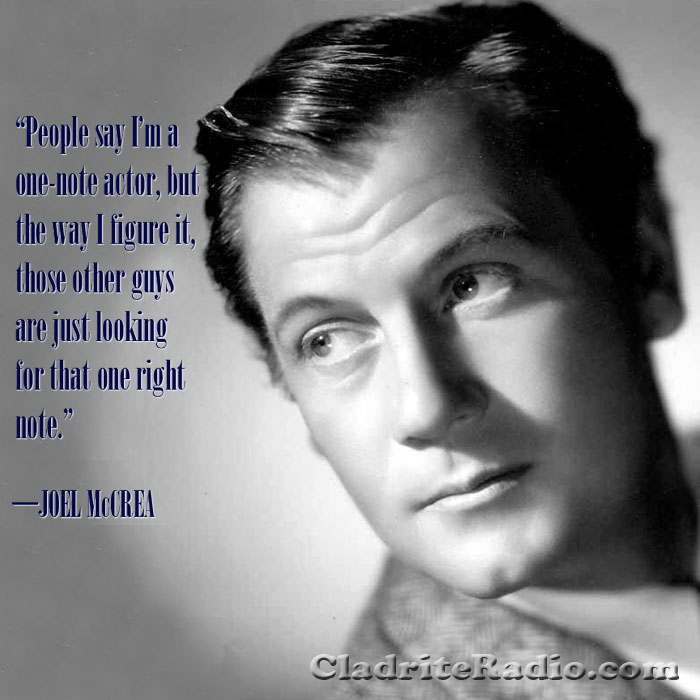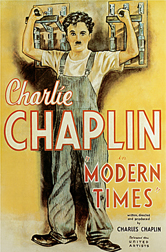Here are 10 things you should know about Joel McCrea, born 117 years ago today. Though he later appeared mostly in westerns, early in his career he starred in everything from screwball and romantic comedies to thrillers and dramas.
Tag: William S. Hart
Happy 111th Birthday, Joel McCrea!
Joel McCrea, who was born 111 years ago today in South Pasadena, California, is a favorite of ours. Though he eventually settled into a long run of western pictures, he had previously proven to be adept at many other types of roles, too, from screwball and romantic comedies to thrillers and dramas. Here are 10 JM Did-You-Knows:
- McCrea’s father was an executive with the L.A. Gas & Electric Company; his mother was a Christian Science practitioner. McCrea had a paper route, delivering the Los Angeles Times to D. W. Griffith and other prominent members of the film community.
- McCrea graduated from Hollywood High School and was a member of the class of ’28 at Pomona College. While in college, he took drama courses and appeared in school productions and also in plays at the Pasadena Playhouse.
- While in high school, McCrea was already working in the film industry. An adept horseman, he worked as a stunt double and “reins holder” for stars such as William S. Hart and Tom Mix.
- Just out of college, McCrea signed with MGM, appearing in The Jazz Age (1929) and earning his first lead role in The Silver Horde (1930). In 1930, he signed with RKO and began to establish his reputation as a handsome leading man.
- McCrea was good friends with Will Rogers, and the Oklahoma cowboy did much to boost McCrea’s career. It was Rogers who encouraged McCrea to put his money into real estate, and that advice made McCrea a millionaire. In fact, he earned more money in real estate than he did as an actor over his 50-year career.
- Katharine Hepburn, close friends with McCrea and his wife, actress Frances Dee, admired McCrea’s abilities as an actor, ranking him with Humphrey Bogart and Spencer Tracy.
- McCrea came by his affinity for all things western—roping, riding, ranching—naturally. His grandfather was a stagecoach driver who survived confrontations with Apache Indians.
- McCrea turned down the lead role in The Postman Aways Rings Twice (1946) that eventually went to John Garfield.
- McCrea got to meet Wyatt Earp in 1928 and had the chance to portray the western legend in Wichita (1955).
- McCrea had the opportunity to reunite with his The More, The Merrier (1943) costars, Jean Arthur and Charles Coburn, in The Impatient Years (1944), but declined the role, which would have found him playing a serviceman, saying, “If I’m too old to be called, I was too old for that kind of show.”
Happy birthday, Joel McCrea, wherever you may be!

Times Square Tintypes: Helen Morgan
FANNY ON THE PIANO
Silence is golden
We enjoyed this video tribute to the silent era, and thought we’d share it with you.
The person behind it, Alejandra Espasande Bouza, is an independent filmmaker based in Los Angeles. She holds a B.A. from the USC School of Cinematic Arts and a M.A. in Moving Image Archive Studies from UCLA. and here’s what she has to say about the project:
This video is a tribute to the forgotten pioneer Hollywood cinematographers who captured the moving images of the silent film era. In turn, these images serve as a reminder of the intrinsic beauty and charm of silent cinema, and the importance of its preservation. To that end, and in the tradition of this historic film period, no narration is employed. Apart from film stars of the time, the video showcases scenes that represent main themes of this film period: slapstick, adventure, horror and romance.
Sit back and enjoy the beauty of these moving images edited to the rhythm of Antonio Vivaldi.
Featured actors include: Gloria Swanson, Rudolph Valentino, Greta Garbo, Clara Bow, Charlie Chaplin, Douglas Fairbanks, William S. Hart, Ben Turpin, Harry Langdon, Buster Keaton, Harry Gribbon, Harold Lloyd, Mary Philbin, Lon Chaney and Roscoe Arbuckle.
If you enjoyed this, cast your vote for Ms. Bouza’s work in the MishMash Getty Images Music/Video/Remix competition.
![]()
Clap hands, here comes Charlie
 Usually, when we have occasion to recommend a film festival or other vintage event, the proceedings are taking place in New York City, the home of Cladrite Headquarters, but our recommendation for this Friday and Saturday is directed at those in Southern California.
Usually, when we have occasion to recommend a film festival or other vintage event, the proceedings are taking place in New York City, the home of Cladrite Headquarters, but our recommendation for this Friday and Saturday is directed at those in Southern California.
We’re not the biggest of Charlie Chaplin fans—among the great silent-movie comedians, Buster Keaton stands above all others in our estimation, with Harold Lloyd coming in second. But we’ve enjoyed our share of laughs over the years, courtesy of the Little Tramp, and we certainly acknowledge and respect the key role he plays in cinematic history.
So it’s with pleasure that we inform you that, this weekend, the Santa Clarita Valley Historical Society, the William S. Hart Park and Museum, the Natural History Museum of Los Angeles County, and the Los Angeles County Department of Parks & Recreation are commemmorating the 75th anniversary of Modern Times, the picture that some say marked the end of the silent era, with a two-day celebration dubbed ChaplinFest.
The Santa Clarita Valley is a fitting site for this event, becuase it was there, on the Sierra Highway near Vasquez Rocks, that Chaplin filmed Modern Times‘ final scene. If you’ve seen the movie, you’ll recall it—the Little Tramp walks off into the distance with Paulette Goddard on his arm.
Chaplin also filmed a scene for The Pilgrim (1923) at the nearby Saugus Train Station, which has been preserved and moved to Heritage Junction park.
ChaplinFest boasts a number of intriguing events over its two days: A screening of Robert Downey Jr.’s biopic Chaplin; a ceremony dedicating a Chaplin monument at William S. Hart Park, with special guests Tippi Hedren and Leonard Maltin; screenings of Modern Times accompanied by artifacts from the movie, including Chaplin’s “Little Tramp” overalls; a book signing withJohn Bengtson, author of Silent Traces: Discovering Early Hollywood Through the Films of Charlie Chaplin; a screening of The Pilgrim at the Heritage Junction Train Station; A rare screening of the recently discovered Keystone comedy A Thief Catcher, with Chaplin as a Keystone Cop, and much more.
If we were within striking distance of Santa Clarita, you can bet we’d be in attendance at ChaplinFest this weekend. Since we’re not, we hope some of our SoCal readers will make it—and perhaps they’ll even send us photos of the event.

